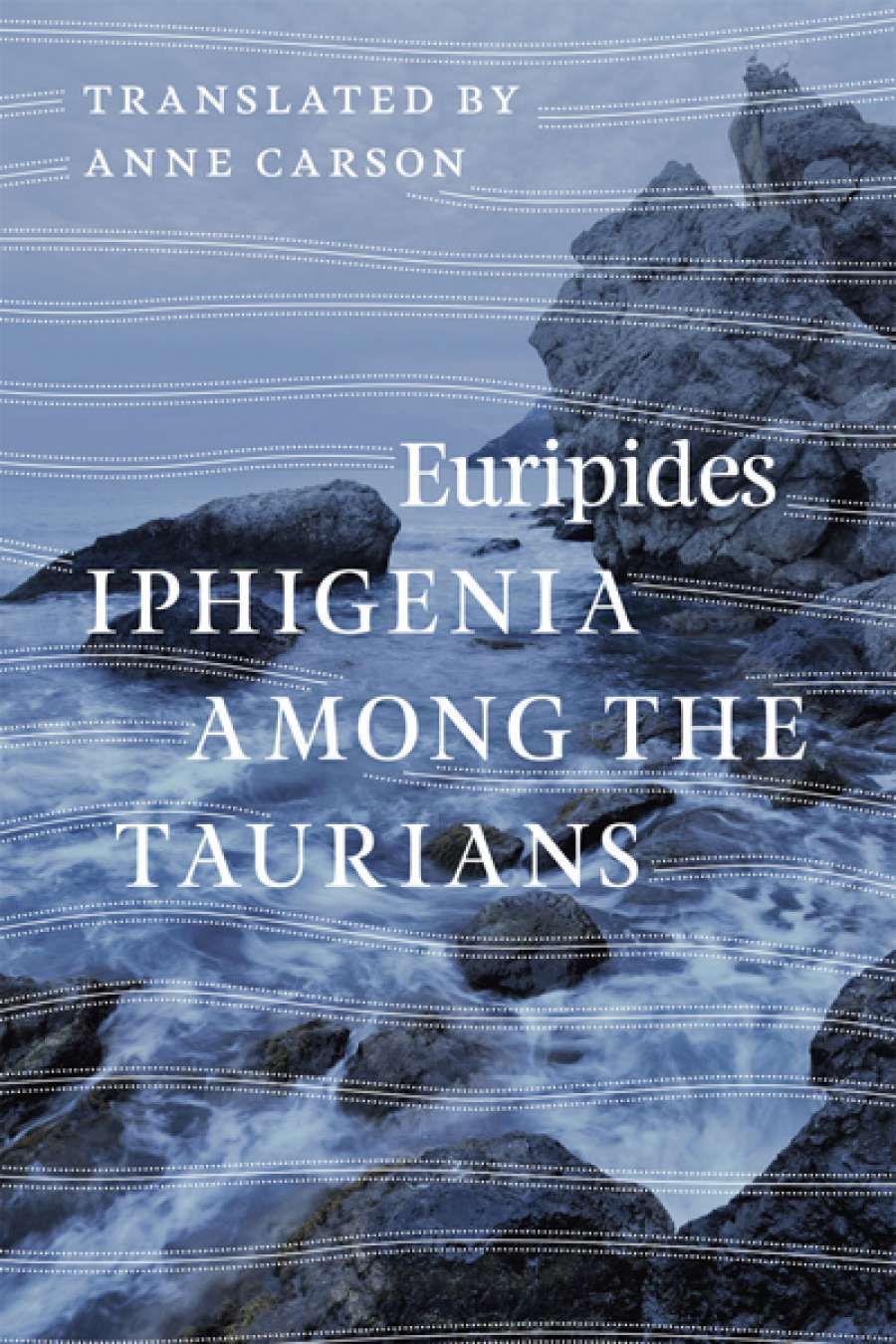
- Free Article: No
- Contents Category: Classics
- Custom Article Title: Maria Takolander reviews 'Iphigenia Among the Taurians' by Euripides translated by Anne Carson
- Review Article: Yes
- Online Only: No
- Book 1 Title: Iphigenia among the Taurians
- Book 1 Biblio: University of Chicago Press (Footprint Books), $19.95 pb, 74 pp, 9780226203621
Iphigenia among the Taurians reimagines the fate of Iphigenia. The play reveals that she was ‘snatched’ away by the goddess Artemis at the fatal moment, a deer sacrificed in her place. Iphigenia is borne through the air to the land of the Taurians, a place of barbarians, where she is appointed priestess at Artemis’s temple. There she oversees the sacrifice of Greek men. ‘I work in blood,’ Iphigenia tells the chorus, ‘making death for strangers.’
With this play Euripides again demonstrates his complex interest in female subjects, famously exemplified by Medea. Iphigenia, like Medea, is an angry woman. Iphigenia among the Taurians explores her sense of injustice at being treated like a ‘sacrificial calf’ by her father. It is in relation to this anger that we can understand her role in the killing of Greek men. It is also her anger that casts Iphigenia, like Medea, as a barbarian. Yet her righteous anger makes of her, if not a goddess herself, then an ally of one. The unresolved issue of gendered injustice is also highlighted by the introduction of Orestes to the action. He enters the land of the Taurians in a desperate attempt to find peace from the Furies, who continue to pursue him for the crime of matricide. The god Apollo has instructed Orestes to steal a statue of Artemis and return with it to Greece in order to be absolved of his suffering.
We are given a glimpse of Orestes’ torment as his ship reaches the land of the Taurians. Mistaken for a shipwrecked sailor by a herdsman, Orestes is observed ‘howling aloud / trembling to the tips of his fingers / and staggering in fits’ as he encounters the awful shapes of the Furies, one with ‘horrible snakes … mouthing out at me’ and another ‘belching fire and death and thrashing her wings’. However, for the herdsman ‘those shapes were not visible. / Only voices of cows and dogs were answering him.’ Here we see how these early playwrights understood their materials as part of a psychological allegory, well before Sigmund Freud began interpreting them in these terms.
‘With this play Euripides again demonstrates his complex interest in female subjects’
Whatever one thinks of Freud’s revision of Greek myth to illustrate aspects of human psychology and behaviour, he was undeniably perspicacious in observing the peculiar domesticity and intimacy of these stories. Ancient Greek myths might be played out on a grand stage involving states and wars, goddesses and gods, but the stories are disturbingly insular, even claustrophobic. In fact, they speak of family violence: its trauma, its legacies, its repetitions. Gender is thoroughly germane to this.
 Nox by Anne Carson (New Directions, 2010)
Nox by Anne Carson (New Directions, 2010)
Of course, stories mean different things to different readers in different places and at different times. If they are so generative, it is precisely because they are so mutable. Carson’s attraction to the particular material in Iphigenia among the Taurians undoubtedly lies somewhere in its exploration of grief. It is fascinating to observe the ways in which this play resonates with Carson’s earlier work Nox (2010), an elegy for her brother, who died in a distant country after many years of being estranged from his family.
Nox is a work exceptional for its restraint. Iphigenia among the Taurians, by contrast, indulges in the kind of excessive display we expect of Greek tragedy. At the start of the play, Iphigenia dreams that Orestes is dead. Her grief, though, feels real. She passionately promises to throw on Orestes’ pyre ‘the flowery brightness of yellow bees’. As the plot progresses, Iphigenia discovers that Orestes is alive, fantastically returned to her from the dead – just as she herself has been magically restored to life by the narrative. Brother and sister plot together to escape the land of the Taurians and their barbarous history, the gods once again intervening to deliver grace.
Some purists might criticise Carson’s translation of Iphigenia among the Taurians, as they did her translations of An Oresteia (2009) and Grief Lessons: Four Plays by Euripides (2006), for its contemporary locutions. However, these plays are not relics, as the urge to revisit them clearly shows. They have haunted artists and audiences across place and time, and continue to do so.


Comments powered by CComment